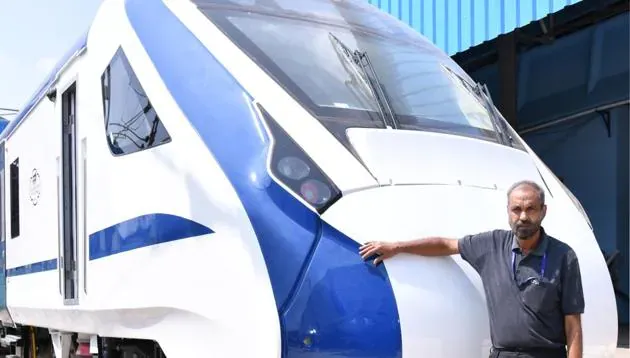- Published on
- Dec 18th 2021
The impressive story behind India's Train 18

Sudanshu Mani provides a first hand record of how Train 18 saw the light of day.
https://www.amazon.in/My-Train-Story-Sudhanshu-Mani/dp/8194897432
Why do our trains look the same year after year? The same metallic box with featureless windows and doors? Sudhanshu Mani, creator of India’s first semi-high speed train set Train-18 Vande Bharat Express and retired general manager of the Indian Railways’ biggest coach factory Integral Coach Factory (ICF), breaks his silence on this most-common question raised in commuters’ minds in his book titled, My Train 18 Story. The newly-released book is peppered with lines by renowned Urdu poets and quotes by William Shakespeare. Mani details how he tried to break that barrier of “babudom” to successfully design and commission India’s first-ever semi-high speed train set. Mani said the heavy layers of bureaucracy tried to scuttle it at every point since the first day, but it was only due to the determination of his team at the ICF that he could do it successfully, with the support of the Chairman, Railway Board and the railway minister.
In 2018, a 16-coach train set, designed for operation speed of 160 kmph and test speed of 180 km/h, was conceived, designed and developed by the ICF under the leadership of Mani. The project was completed in record time of about 18 months as against the industry standard of about three to four years. The train cost—from the drawing board to its final physical form running on a track — R97 crore, which was nearly one third the estimated price of importing such a train. The train, designated as Train 18 and subsequently launched as the Vande Bharat Express, became an instant success and came to represent the inherent innovative spirit of a new India. It was flagged off for an inaugural run by Prime Minister Narendra Modi on February 15, 2019.
“Over the years in the Indian Railway trains, the only thing which changed has been the colour [from gulf red to blue]. Introduction of air-conditioned coaches was a minor mutation, but that happened 40 years ago, and these AC coaches have absolutely the same recall. So why does a large 170-year-old organisation with thousands of lookalike trains keep churning out more similar-looking ones?” he asks.
Mani says that Indian Railways has a long history and legacy of close to two centuries. But clarifies saying, “My book is not about this legacy. It is about my despair and anguish. I have for you in this book, the story of the making of Train 18. This was the first time that our country got a fully homegrown modern rolling stock, i.e., a railway vehicle for which the concept to design engineering to manufacture to validation and testing was done entirely in India at ICF Chennai. This is not a story of one man alone, it is the story of a dedicated team of Indians telling you that we, in India, can also do it.”
Mani narrates how he had to break the ice and get permission from the then railway board chairman late AK Mittal for the manufacture of just two such trains at the factory when other board members suggested that they could import it. “I pleaded. ‘Sir, you are the Chairman so no one can hold you back. You say ICF can do it. Let the board import what they want, give me the sanction for just two trains and I will make it at a cost that’s one third of the imported price. And sir, I am going to grab your feet now and not let go till you give me this sanction’.”
All this convincing was necessary because the bureaucracy in the Indian Railways is traditional minded. One wing maintains coaches and another is for locomotives. This was a train set that was neither a coach nor a locomotive, so who would do it? Who would own the train?
“But after hard work and determination, we could turn out the best possible product and today everyone is proud of it. We faced troubles and vigilance inquiries and are still facing problems, but we showed the world that India could manufacture the best,” he beams.
After initially almost disowning it, leading to delays and a host of technical studies, Indian Railways has now planned to order 44 sets of Train 18 by 2022, but indications are that the project will be delayed well into 2024.